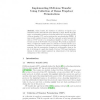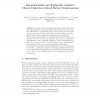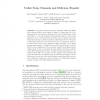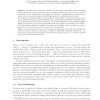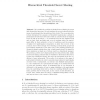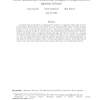TCC
2004
Springer
15 years 6 months ago
2004
Springer
Abstract. Until recently, the existence of collection of trapdoor permutations (TDP) was believed (and claimed) to imply almost all of the major cryptographic primitives, including...
105
click to vote
TCC
2004
Springer
15 years 6 months ago
2004
Springer
Recently Canetti, Krawczyk and Nielsen defined the notion of replayable adaptive chosen ciphertext attack (RCCA) secure encryption. Essentially a cryptosystem that is RCCA secure ...
108
click to vote
TCC
2004
Springer
15 years 6 months ago
2004
Springer
In a paper from EuroCrypt’99, Damg˚ard, Kilian and Salvail show various positive and negative results on constructing Bit Commitment (BC) and Oblivious Transfer (OT) from Unfair...
112
click to vote
TCC
2004
Springer
15 years 6 months ago
2004
Springer
Quantum 2-party cryptography differs from its classical counterpart in at least one important way: Given blak-box access to a perfect commitment scheme there exists a secure 1−2...
TCC
2004
Springer
15 years 6 months ago
2004
Springer
We show how to public-key obfuscate two commonly used shuffles: decryption shuffles which permute and decrypt ciphertexts, and re-encryption shuffles which permute and re-encrypt c...
126
click to vote
TCC
2004
Springer
15 years 6 months ago
2004
Springer
We consider the problem of threshold secret sharing in groups with hierarchical structure. In such settings, the secret is shared among a group of participants that is partitioned ...
127
click to vote
TCC
2004
Springer
15 years 6 months ago
2004
Springer
We explore the notion of a pseudo-free group, first introduced by Hohenberger [Hoh03], and provide an alternative stronger definition. We show that if Z∗ n is a pseudo-free abe...
106
click to vote
TCC
2004
Springer
15 years 6 months ago
2004
Springer
In earlier work, we described a “pathological” example of a signature scheme that is secure in the Random Oracle Model, but for which no secure implementation exists. For that...
TCC
2004
Springer
15 years 6 months ago
2004
Springer
115
click to vote
TCC
2004
Springer
15 years 6 months ago
2004
Springer
Abstract. We present a general method to prove security properties of cryptographic protocols against active adversaries, when the messages exchanged by the honest parties are arbi...
